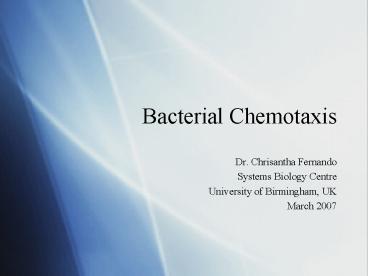Bacterial Chemotaxis - PowerPoint PPT Presentation
1 / 31
Title:
Bacterial Chemotaxis
Description:
CheR methylates. and sensitizes. CheB de-methylates. and desensitizes. CheB is activated by ... CheR. Tar complex (E) in methylated and unmethylated form ... – PowerPoint PPT presentation
Number of Views:1812
Avg rating:3.0/5.0
Title: Bacterial Chemotaxis
1
Bacterial Chemotaxis
- Dr. Chrisantha Fernando
- Systems Biology Centre
- University of Birmingham, UK
- March 2007
2
Thanks to
- Uri Alon. The core of this lecture is based on a
lecture given by Uri Alon, available at - http//www.weizmann.ac.il/mcb/UriAlon/
- Actually you can even here him giving the lecture
in audio. I highly recommend it.
3
Rating 18 Neutrophil follows and kills bacteria
4
What is Chemotaxis?
Rapid Response
5
(No Transcript)
6
Cant measure spatial gradients!
Difference in chemical too small to be detected
7
Runs and Tumbles
Berg, Brown, 1972
8
(No Transcript)
9
Due to Clockwise or Anti-Clockwise of Flagella
Motor
10
Adaptation of tumbling frequency
EXACT
Well mixed reactor Measure tumbles Add
attractant
Adaptation time
Add attractant
11
Exact Adaptation
- The steady state tumbling frequency is
independent of the attractant concentration.
12
Mechanism?
6 proteins control this computation. Adler.
Attractant binds
Receptor/Kinase
1000 receptors
Kentner and Sourjik
30 binding sites for CheY on motor
Cooperativity.
CheY-P increases the prob. that motor turns
clockwise, I.e producing tumbling.
Clockwise/Anti-Clock
13
(No Transcript)
14
Add attractant
Attractant shuts off kinase CheY gets
de-phosphorylated Tumbles decrease rapidly But
how does adaptation occur, i.e increased tumbling
again?
15
Adaptation
Methylation can sensitize the detector This
happens slowly, to an extent determined by two
oppositely acting proteins.
16
CheR methylates and sensitizes CheB
de-methylates and desensitizes CheB is activated
by CheY-P, i.e. negative feedback loop.
17
(No Transcript)
18
- How robust is this circuit to change in protein
concentration? Uri Alon asked whether it was
fine tuned or robust.
Behaviour Styles!
19
Experiments to alter protein levels in real
bacteria.
- Compute average tumbling frequency of population
using image processing. - A variety of individual differences were found
even in genetically identical organisms
nervous vs. relaxed.
20
(No Transcript)
21
Robust feature
Not robust
Not robust
22
(No Transcript)
23
Why is exact adaptation robust?
- Adaptation time and tumbling frequency is not
robust. - Mutants with only partial adaptation (no CheR and
CheB) have 1 normal chemotaxis ability. - Hypothesis Chemotaxis mechanism evolved so that
exact adaptation was robust to variation in
protein level changes. - Is it possible to have a good chemotaxis
mechanism without exact adaptation?
24
Protein is noisy
- Sometimes only 20 copies of a protein in a cell.
This will vary due to noise in transcription and
translation. - Imagine making a circuit that had to be robust to
very unreliable and poorly specified electrical
parts.
25
(No Transcript)
26
CheB
Active
Em
Output
E
CheR
Input u
Inactive
- Tar complex (E) in methylated and unmethylated
form - Ligand binds to methylated form only, and
inactivates - We require a steady fixed active Em.
- So, in proportion to Em active, we destroy Em
- This means, if u is increased, there is less
Em, so less destruction of Em so, Em again
increases to its steady state. - Or, if u is decreased, Em is increased, and
so Em destruction rate increases so again
reducing Em to steady state.
Em
27
Binds to only Methylated receptors
Chemoattractant
Active receptor
Rate of de-methylation By CheB
28
(No Transcript)
29
Problems with Current Explanations
- Explaining how the Tar complex can be so
sensitive (high gain) over many orders of
magnitude.
30
(No Transcript)
31
Dennis Bray Outstanding Issues
- http//www.pdn.cam.ac.uk/groups/comp-cell/Question
s.html

